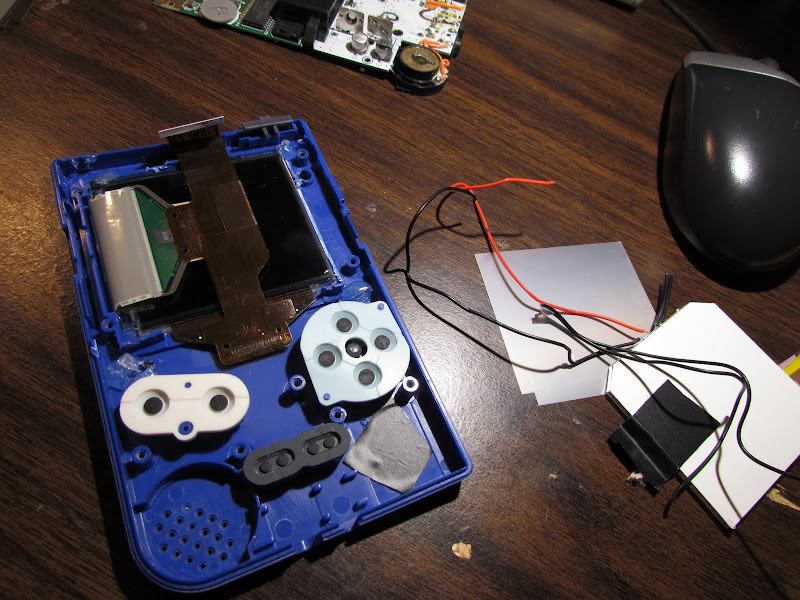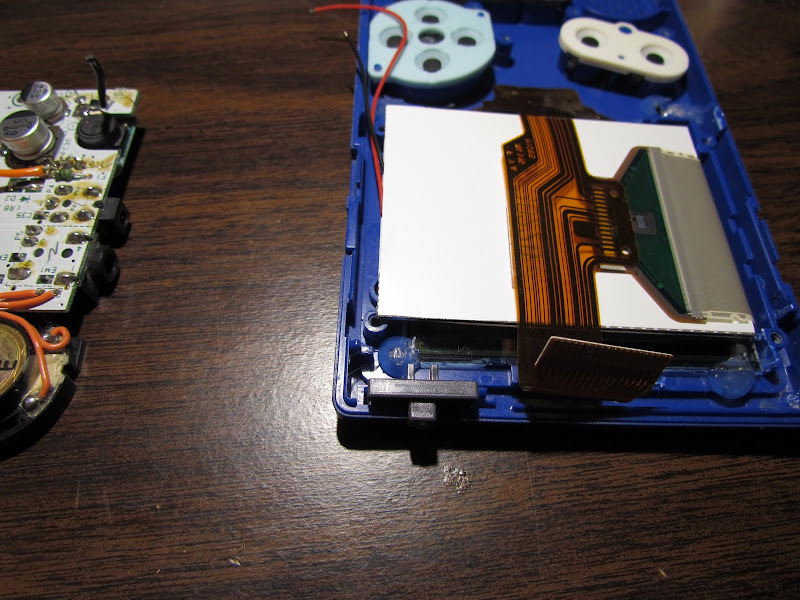So I was recently sent a Kitsch-Bent LEDx3 backlight for testing in my MGB, or Gameboy Pocket in layman's terms. I was hopeful that this one would work much better than the RGB-VA adjustable backlight because it's very thin. It worked out nicely, and I took a bunch of pictures documenting the process of installing it. I would say the install was a good bit harder than a DMG, but that's partly because the MGB is just harder to mod, and partly because the screen, while thin enough, was not designed with the space constraints of the MGB in mind.
So, to begin with I had the backlight kit, which was an inverted white model, and my blue MGB, which has had about four different backlights in it so far, including one made of CD-case material, one from an iPod backlight, one from a broken DS Lite, and the RGB-VA.

I had to remove the old RGB-VA first, which involved snipping off the wires to the PCB and removing the old panel. I left the PCB in place since it covers the holes in the shell. The old backlight was a real mess, as I seriously mangled some stuff to get it forced in there, only to find it wasn't going to work anyways.


At this point I made sure the LCD was still working, which it was:

Upon inserting the new panel I noted that it was going to block two important screw posts, and would need to be modified. Since there would be no way to hold the front of the gameboy on properly without these posts I had to hack the LEDx3 panel itself.

So my highly scientific (lol) method of planning the hole locations and checking to see if it was okay to chop there was to mark them with red sharpie and then illuminate the panel while looking at the backside. The LEDs didn't look like they were in the locations I wanted to chop, so I hacked off the corners with a razor knife.


And it still worked after having it's corners lopped off.

After that the only other thing that was in the way was the power LED, which I simply heated up with the iron and plucked from the PCB. (use pliers, those buggers get HOT)

After that the whole assembly fit quite nicely, and looks pretty good too. I forgot to take a picture of where I wired up the panel to, and I probably should have used a smaller resistor value, since the MGB's power supply provides different voltage and current amounts. But it looks good as-is.


Big thanks go to Matt of Kitsch Bent for sending me this screen to test out for him. If you're looking for a good screen for your MGB and don't mind a little work, this one is a good pick.
Some other notes for people who want to mod their MGB for backlight:
- The surround around the inside of the case which holds the screen will need to be cut, pretty aggressively too. I use hot glue to hold everything in once I have it lined up.
- The surround for the old power LED will also need to be cut down.
I might detail this process a bit more later, so consider this more of a review than a real install tutorial.
In the meantime, here are even more pictures:
https://picasaweb.google.com/arf.at.sjv/LEDx3InAnMGB